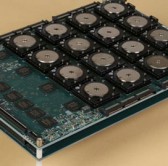
IBM researchers have produced a computer chip that is designed to simulate human brain function without needing to consume large amounts of energy under the Defense Advanced Research Projects Agency‘s SyNAPSE program.
The computing architecture is built with 5.4 billion transistors and 256 million programmable logic points that are modeled after the brain’s neuronal structure, DARPA said Thursday.
DARPA believes the technology could help extend the battery power of remote sensors, mobile robots and other electronic equipment for military usage.
“IBM’s chip, which is by far the largest one yet made that exploits these ideas, could give unmanned aircraft or robotic ground systems with limited power budgets a more refined perception of the environment, distinguishing threats more accurately and reducing the burden on system operators,†said Gill Pratt, a DARPA program manager.
The company said Thursday that it built the “cognitive” chip using a Samsung 28-nanometer process technology and with help from Cornell Tech and iniLabs Ltd.
According to IBM, the architecture’s digital neurosynaptic cores operate in an asynchronous manner and integrate computation, memory and communication features.
“These brain-inspired chips could transform mobility, via sensory and intelligent applications that can fit in the palm of your hand but without the need for Wi-Fi,” said Dr. Dharmendra Modha, chief scientist for brain-inspired computing at IBM Research.
“We foresee new generations of information technology systems – that complement today’s von Neumann machines – powered by an evolving ecosystem of systems, software, and services,†Modha added.
DARPA has provided $53 million in funding since 2008 to support IBM-led neural network chip development project.
The company has developed a curriculum for employees, customers, partners and academic institutions that are interested in building neurosynaptic systems.




